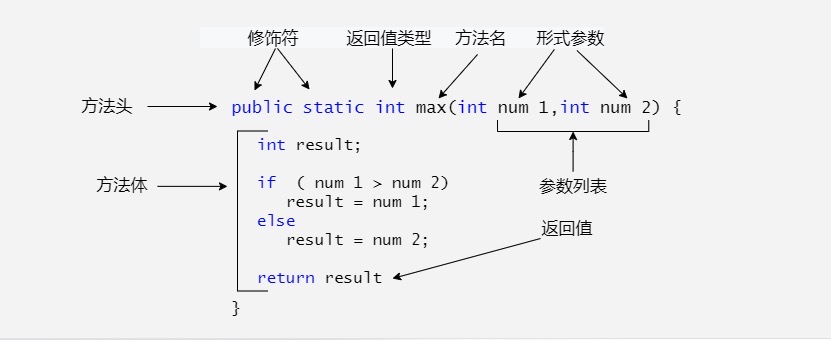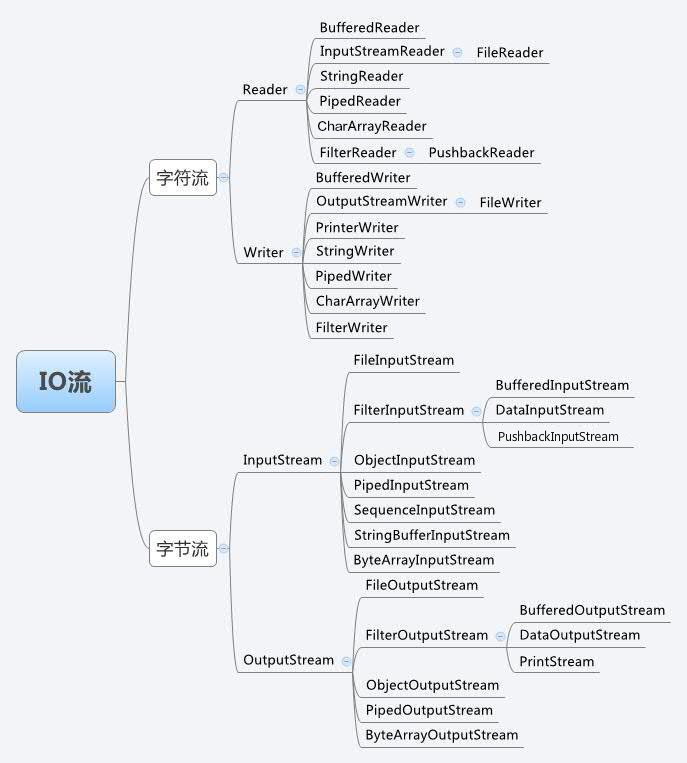Java 方法
在前面几个章节中我们经常使用到 System.out.println(),那么它是什么呢?
- println() 是一个方法。
- System 是系统类。
- out 是标准输出对象。
这句话的用法是调用系统类 System 中的标准输出对象 out 中的方法 println()。

方法的重载
public static double max(double num1, double num2) {
if (num1 > num2)
return num1;
else
return num2;
}
|
构造方法
可变参数
一个方法中只能指定一个可变参数,它必须是方法的最后一个参数。任何普通的参数必须在它之前声明。
public class VarargsDemo {
public static void main(String[] args) {
printMax(34, 3, 3, 2, 56.5);
printMax(new double[]{1, 2, 3});
}
public static void printMax( double... numbers) {
if (numbers.length == 0) {
System.out.println("No argument passed");
return;
}
double result = numbers[0];
for (int i = 1; i < numbers.length; i++){
if (numbers[i] > result) {
result = numbers[i];
}
}
System.out.println("The max value is " + result);
}
}
|
Java 流(Stream)、文件(File)和IO
从控制台读取多字符输入
import java.io.*;
public class BRRead {
public static void main(String[] args) throws IOException {
char c;
BufferedReader br = new BufferedReader(new InputStreamReader(System.in));
System.out.println("输入字符, 按下 'q' 键退出。");
do {
c = (char) br.read();
System.out.println(c);
} while (c != 'q');
}
}
|
从控制台读取字符串
import java.io.*;
public class BRReadLines {
public static void main(String[] args) throws IOException {
BufferedReader br = new BufferedReader(new InputStreamReader(System.in));
String str;
System.out.println("Enter lines of text.");
System.out.println("Enter 'end' to quit.");
do {
str = br.readLine();
System.out.println(str);
} while (!str.equals("end"));
}
}
|
控制台输出
import java.io.*;
public class WriteDemo {
public static void main(String[] args) {
int b;
b = 'A';
System.out.write(b);
System.out.write('\n');
}
}
|
write() 方法不经常使用,因为 print() 和 println() 方法用起来更为方便。
读写文件

FileOutputStream
该类用来创建一个文件并向文件中写数据。
OutputStream f = new FileOutputStream(“C:/java/hello”)
- 1 public void close() throws IOException{}
关闭此文件输入流并释放与此流有关的所有系统资源。抛出IOException异常。
- 2 protected void finalize()throws IOException {}
这个方法清除与该文件的连接。确保在不再引用文件输入流时调用其 close 方法。抛出IOException异常。
- 3 public void write(int w)throws IOException{}
这个方法把指定的字节写到输出流中。
- 4 public void write(byte[] w)
把指定数组中w.length长度的字节写到OutputStream中。
import java.io.*;
public class fileStreamTest {
public static void main(String[] args) {
try {
byte bWrite[] = { 11, 21, 3, 40, 5 };
OutputStream os = new FileOutputStream("test.txt");
for (int x = 0; x < bWrite.length; x++) {
os.write(bWrite[x]);
}
os.close();
InputStream is = new FileInputStream("test.txt");
int size = is.available();
for (int i = 0; i < size; i++) {
System.out.print((char) is.read() + " ");
}
is.close();
} catch (IOException e) {
System.out.print("Exception");
}
}
}
|
以上代码由于是二进制写入,可能存在乱码,你可以使用以下代码实例来解决乱码问题:
import java.io.*;
public class fileStreamTest2 {
public static void main(String[] args) throws IOException {
File f = new File("a.txt");
FileOutputStream fop = new FileOutputStream(f);
OutputStreamWriter writer = new OutputStreamWriter(fop, "UTF-8");
writer.append("中文输入");
writer.append("\r\n");
writer.append("English");
writer.close();
fop.close();
FileInputStream fip = new FileInputStream(f);
InputStreamReader reader = new InputStreamReader(fip, "UTF-8");
StringBuffer sb = new StringBuffer();
while (reader.ready()) {
sb.append((char) reader.read());
}
System.out.println(sb.toString());
reader.close();
fip.close();
}
}
|
Java中的目录
import java.io.File;
public class CreateDir {
public static void main(String[] args) {
String dirname = "/tmp/user/java/bin";
File d = new File(dirname);
d.mkdirs();
}
}
|
读取目录
import java.io.File;
public class DirList {
public static void main(String args[]) {
String dirname = "/tmp";
File f1 = new File(dirname);
if (f1.isDirectory()) {
System.out.println("目录 " + dirname);
String s[] = f1.list();
for (int i = 0; i < s.length; i++) {
File f = new File(dirname + "/" + s[i]);
if (f.isDirectory()) {
System.out.println(s[i] + " 是一个目录");
} else {
System.out.println(s[i] + " 是一个文件");
}
}
} else {
System.out.println(dirname + " 不是一个目录");
}
}
}
|
删除目录或文件
import java.io.File;
public class DeleteFileDemo {
public static void main(String[] args) {
File folder = new File("/tmp/java/");
deleteFolder(folder);
}
public static void deleteFolder(File folder) {
File[] files = folder.listFiles();
if (files != null) {
for (File f : files) {
if (f.isDirectory()) {
deleteFolder(f);
} else {
f.delete();
}
}
}
folder.delete();
}
}
|






